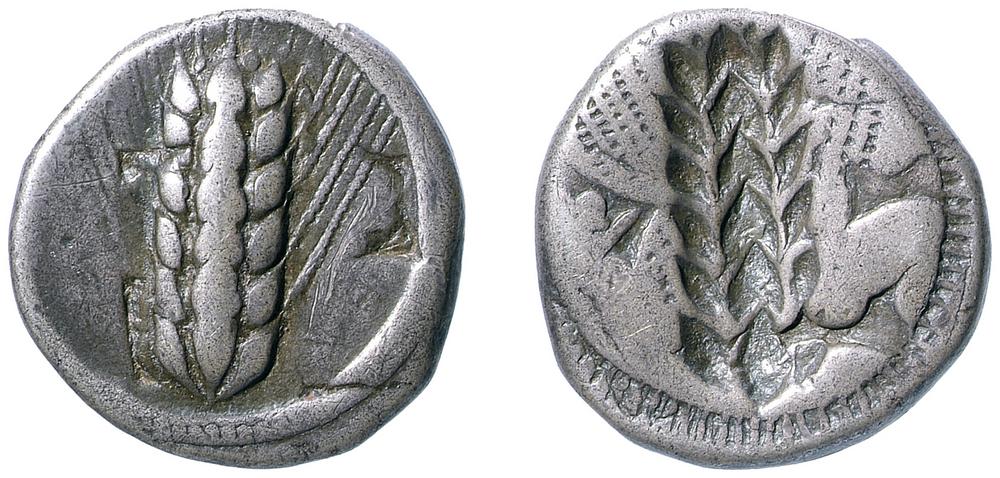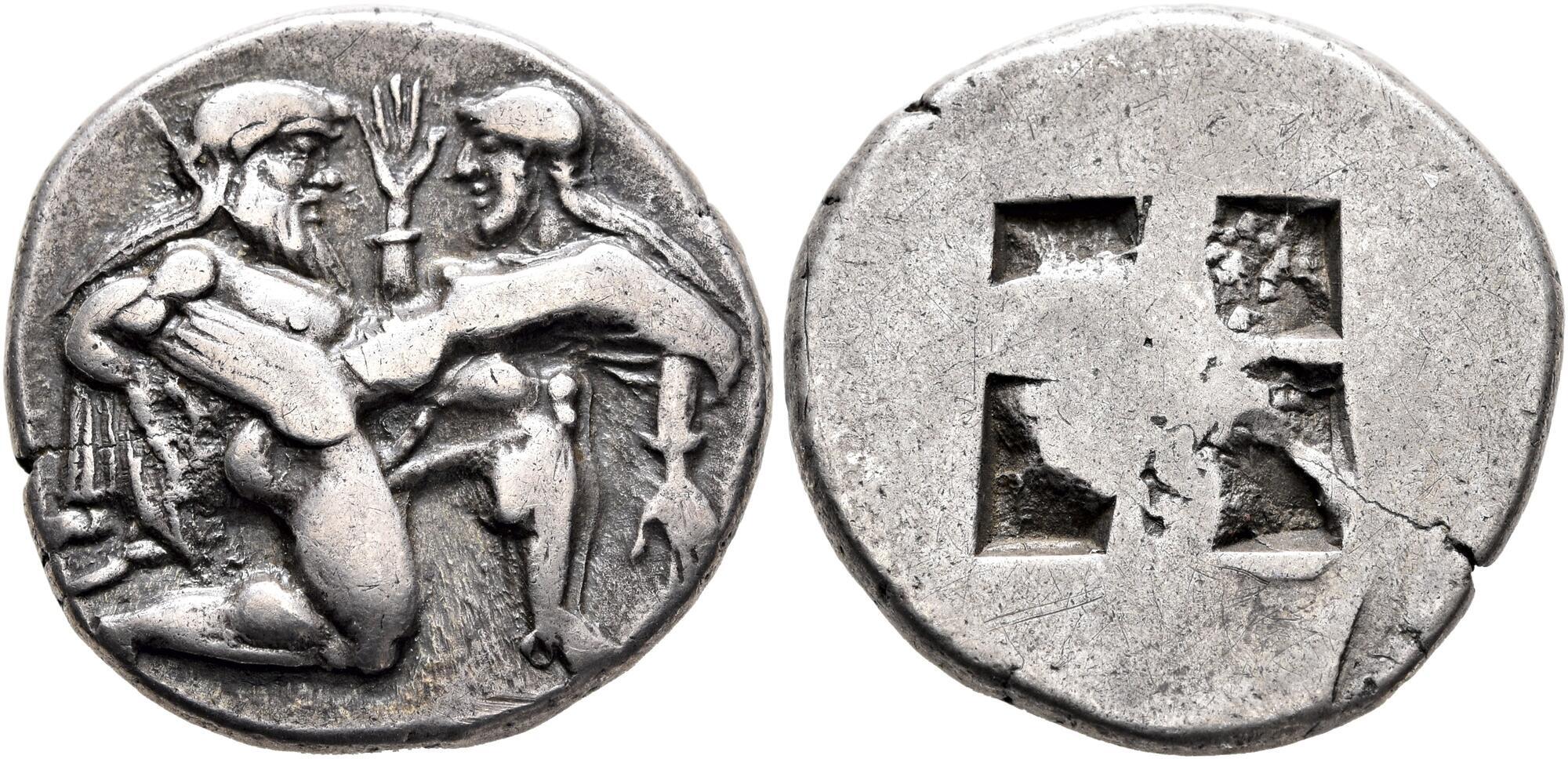2033 - Metapontum (nomos ear of barley/ear of barley) over Thasos (Silenus and maenad/incuse square) (London, BM, 1946-1-1.315)
From SILVER
470 BCE - 440 BCEMETA
Location/history
| Museum collectionMuseum collection: | London, British Museum, 1946-1-1.315 | Sale(s)Sale(s) ᵖ: | Sambon and Canessa (Paris), 14, 1900, 56 |
| Private collection(s)Private collection(s) ᵖ: | Luigi dell'Erba, Arthur Evans, Lloyd collection, n° 315 |
Overstriking coin
Description
| ObverseInscription or printing placed on the obverse.: | META (Greek) Ear of barley. Decorated border. | ReverseInscription or printing placed on the reverse.: | Incuse ear of barley. Border of rays. |
Mint and issuing power
| MintIdentifies the place of manufacture or issue of a numismatic object.: | Metapontum | Ancient regionAncient region. | Lucania | Modern countryModern country: Italy | AuthorityIdentifies the issuing power. The authority can be "pretended" when the name or the portrait of X is on the coin but he/she was not the issuing power. It can also be "uncertain" when there is no mention of X on the coin but he/she was the issuing power according to the historical sources: |
Chronology
| FromIdentifies the initial date in a range assigned in a numismatic context. 470 BCE toIdentifies the final date in a range assigned in a numismatic context.. 440 BCE | Classical 480-323 BC |
Physical description
| MetalThe physical material (usually metal) from which an object is made.: Silver |
WeightWeight of the numismatic object (in grams). in grams: 7.557.55 g <br />7,550 mg <br /> | DenominationTerm indicating the value of a numismatic object. Examples: tetradrachm, chalkous, denarius.: nomos | AxisDescribes the directional relationship between the obverse and reverse of a numismatic object.: 1212 mm <br />1.2 cm <br /> |
| StandardStandard.: Achaian | |||
References
| Coin referenceReference of the Coin: | Noe 1957, group IV, p. 26, pl. VIII, f), Sylloge Nummorum Graecorum: Lloyd Collection II, n° 315 | Coin series referenceReference to coin series study: | Noe 19571Noe 1957, group IV, p. 26, pl. VIII, f, SNG Lloyd2SNG Lloyd, n° 315, HN Italy3HN Italy, n° 1484, HGC 14HGC 1, n° 1027-1029 |
| Coin series web referenceCoin series web references: | |||
Overstruck type
Description
| ObverseInscription or printing placed on the obverse.: | Nude ithyphallic satyr, with long beard and long hair, moving right in 'running-kneeling' position, holding a nymph in his arms, who raises her right hand in protest | ReverseInscription or printing placed on the reverse.: | Quadripartite incuse square |
Mint and issuing power
| MintIdentifies the place of manufacture or issue of a numismatic object. ᵖ: | Thasos | Ancient regionAncient region. ᵖ | Thrace | Modern countryModern country: Greece | AuthorityIdentifies the authority in whose name (explicitly or implicitly) a numismatic object was issued. ᵖ: |
Chronology
| FromIdentifies the initial date in a range assigned in a numismatic context. 480 BCE toIdentifies the final date in a range assigned in a numismatic context.. 460 BCE | Classical 480-323 BC |
Physical description
| DenominationTerm indicating the value of a numismatic object. Examples: tetradrachm, chalkous, denarius. ᵖ: | stater |
References
| Coin type referenceReference to coin series study ᵖ: | HGC 65HGC 6, n° 331 |
Additional data
| Frequency of overstrikesFrequency of overstrikes: | frequent | Level of confidenceLevel of confidence of the identification: | sure |
| RemarksRemarks: | |||
References
- ^ Noe, Sydney P. (1957), "Overstrikes in Magna Graecia", American Numismatic Society. Museum Notes 7, p. 13-42, pl. 5-14.
- ^ Sylloge Nummorum Graecorum, Great Britain Vol. 2 : The Lloyd Collection. Part 1-2 Etruria to Thurium, Part 3-4 Velia to Eryx, Part 5-6 Galaria to Selinus, Part 7-8 Syracuse to Lipara
- ^ Rutter N. Keith et alii (eds.) (2001), Historia Numorum Italy, London, xvi, 223 p., 43 pl.
- ^ Hoover, Oliver D. (2018), The Handbook of Greek Coinage Series, Volume 1. Handbook of Coins of Italy and Magna Graecia, Sixth to First Centuries BC., Lancaster-London, 2018, lxi, 527 pages, 23 cm
- ^ Hoover, Oliver D. (2010), The Handbook of Greek Coinage Series, volume 6 : handbook of coins of the islands: Adriatic, Iionian, Thracian, Aegean, and Carpathian seas (excluding Crete and Cyprus), sixth to first centuries BC, Lancaster, 358 p.

